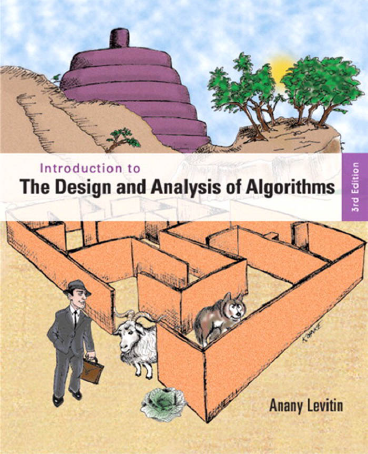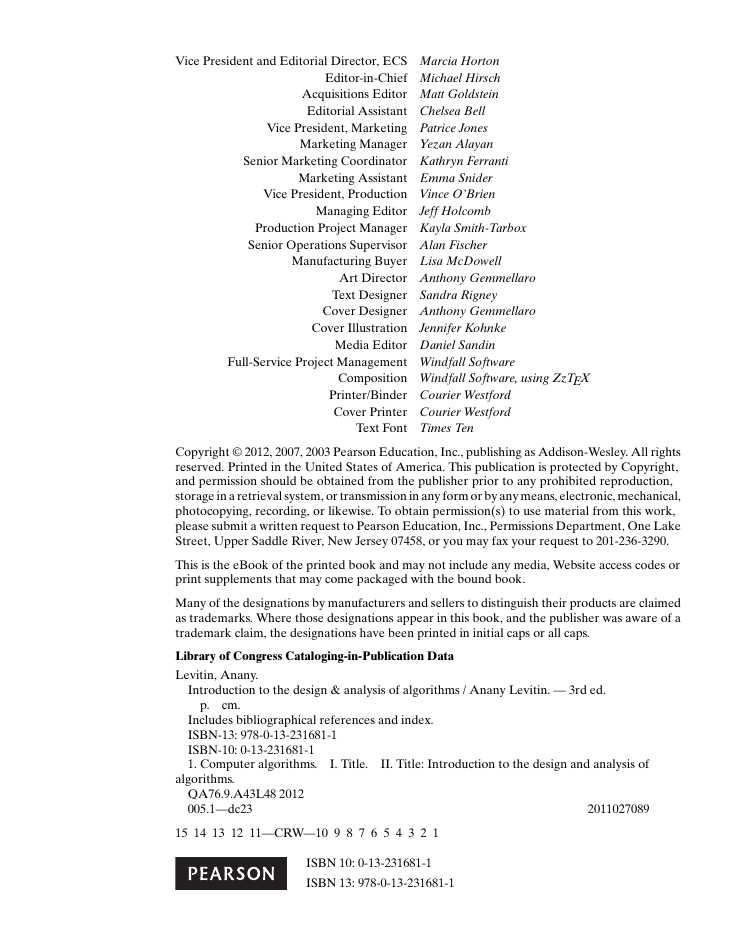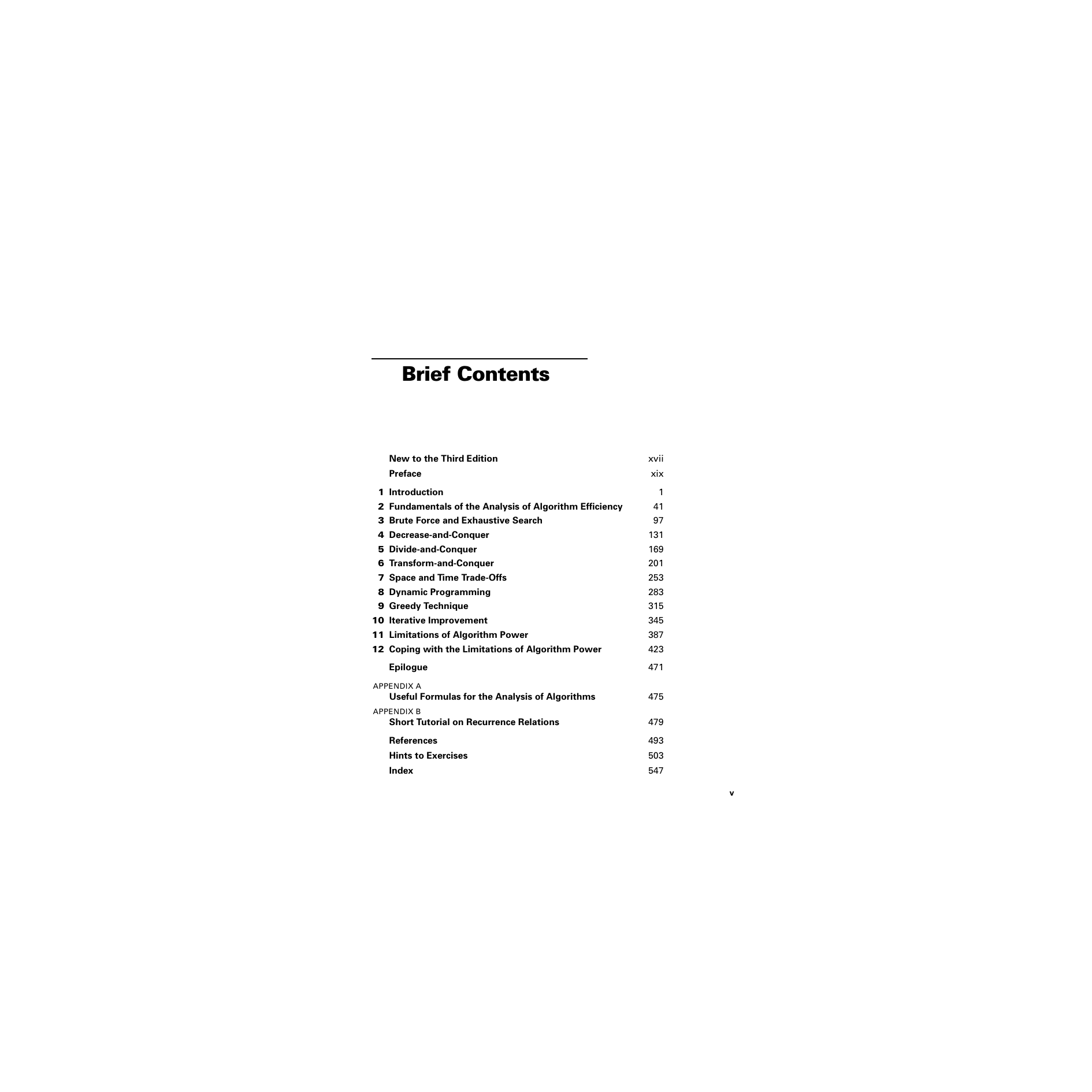Cover
Copyright Page
Title Page
Brief Contents
Contents
New to the Third Edition
Preface
Acknowledgments
1 Introduction
1.1 What Is an Algorithm?
Exercises 1.1
1.2 Fundamentals of Algorithmic Problem Solving
Understanding the Problem
Ascertaining the Capabilities of the Computational Device
Choosing between Exact and Approximate Problem Solving
Algorithm Design Techniques
Designing an Algorithm and Data Structures
Methods of Specifying an Algorithm
Proving an Algorithm’s Correctness
Analyzing an Algorithm
Coding an Algorithm
Exercises 1.2
1.3 Important Problem Types
Sorting
Searching
String Processing
Graph Problems
Combinatorial Problems
Geometric Problems
Numerical Problems
Exercises 1.3
1.4 Fundamental Data Structures
Linear Data Structures
Graphs
Trees
Sets and Dictionaries
Exercises 1.4
Summary
2 Fundamentals of the Analysis of Algorithm Efficiency
2.1 The Analysis Framework
Measuring an Input’s Size
Units for Measuring Running Time
Orders of Growth
Worst-Case, Best-Case, and Average-Case Efficiencies
Recapitulation of the Analysis Framework
Exercises 2.1
2.2 Asymptotic Notations and Basic Efficiency Classes
Informal Introduction
O-notation
Ω-notation
Θ-notation
Useful Property Involving the Asymptotic Notations
Using Limits for Comparing Orders of Growth
Basic Efficiency Classes
Exercises 2.2
2.3 Mathematical Analysis of Nonrecursive Algorithms
Exercises 2.3
2.4 Mathematical Analysis of Recursive Algorithms
Exercises 2.4
2.5 Example: Computing the nth Fibonacci Number
Exercises 2.5
2.6 Empirical Analysis of Algorithms
Exercises 2.6
2.7 Algorithm Visualization
Summary
3 Brute Force and Exhaustive Search
3.1 Selection Sort and Bubble Sort
Selection Sort
Bubble Sort
Exercises 3.1
3.2 Sequential Search and Brute-Force String Matching
Sequential Search
Brute-Force String Matching
Exercises 3.2
3.3 Closest-Pair and Convex-Hull Problems by Brute Force
Closest-Pair Problem
Convex-Hull Problem
Exercises 3.3
3.4 Exhaustive Search
Traveling Salesman Problem
Knapsack Problem
Assignment Problem
Exercises 3.4
3.5 Depth-First Search and Breadth-First Search
Depth-First Search
Breadth-First Search
Exercises 3.5
Summary
4 Decrease-and-Conquer
4.1 Insertion Sort
Exercises 4.1
4.2 Topological Sorting
Exercises 4.2
4.3 Algorithms for Generating Combinatorial Objects
Generating Permutations
Generating Subsets
Exercises 4.3
4.4 Decrease-by-a-Constant-Factor Algorithms
Binary Search
Fake-Coin Problem
Russian Peasant Multiplication
Josephus Problem
Exercises 4.4
4.5 Variable-Size-Decrease Algorithms
Computing a Median and the Selection Problem
Interpolation Search
Searching and Insertion in a Binary Search Tree
The Game of Nim
Exercises 4.5
Summary
5 Divide-and-Conquer
5.1 Mergesort
Exercises 5.1
5.2 Quicksort
Exercises 5.2
5.3 Binary Tree Traversals and Related Properties
Exercises 5.3
5.4 Multiplication of Large Integers and Strassen’s Matrix Multiplication
Multiplication of Large Integers
Strassen’s Matrix Multiplication
Exercises 5.4
5.5 The Closest-Pair and Convex-Hull Problems by Divide-and-Conquer
The Closest-Pair Problem
Convex-Hull Problem
Exercises 5.5
Summary
6 Transform-and-Conquer
6.1 Presorting
Exercises 6.1
6.2 Gaussian Elimination
LU Decomposition
Computing a Matrix Inverse
Computing a Determinant
Exercises 6.2
6.3 Balanced Search Trees
AVL Trees
2-3 Trees
Exercises 6.3
6.4 Heaps and Heapsort
Notion of the Heap
Heapsort
Exercises 6.4
6.5 Horner’s Rule and Binary Exponentiation
Horner’s Rule
Binary Exponentiation
Exercises 6.5
6.6 Problem Reduction
Computing the Least Common Multiple
Counting Paths in a Graph
Reduction of Optimization Problems
Linear Programming
Reduction to Graph Problems
Exercises 6.6
Summary
7 Space and Time Trade-Offs
7.1 Sorting by Counting
Exercises 7.1
7.2 Input Enhancement in String Matching
Horspool’s Algorithm
Boyer-Moore Algorithm
Exercises 7.2
7.3 Hashing
Open Hashing (Separate Chaining)
Closed Hashing (Open Addressing)
Exercises 7.3
7.4 B-Trees
Exercises 7.4
Summary
8 Dynamic Programming
8.1 Three Basic Examples
Exercises 8.1
8.2 The Knapsack Problem and Memory Functions
Memory Functions
Exercises 8.2
8.3 Optimal Binary Search Trees
Exercises 8.3
8.4 Warshall’s and Floyd’s Algorithms
Warshall’s Algorithm
Floyd’s Algorithm for the All-Pairs Shortest-Paths Problem
Exercises 8.4
Summary
9 Greedy Technique
9.1 Prim’s Algorithm
Exercises 9.1
9.2 Kruskal’s Algorithm
Disjoint Subsets and Union-Find Algorithms
Exercises 9.2
9.3 Dijkstra’s Algorithm
Exercises 9.3
9.4 Huffman Trees and Codes
Exercises 9.4
Summary
10 Iterative Improvement
10.1 The Simplex Method
Geometric Interpretation of Linear Programming
An Outline of the Simplex Method
Further Notes on the Simplex Method
Exercises 10.1
10.2 The Maximum-Flow Problem
Exercises 10.2
10.3 Maximum Matching in Bipartite Graphs
Exercises 10.3
10.4 The Stable Marriage Problem
Exercises 10.4
Summary
11 Limitations of Algorithm Power
11.1 Lower-Bound Arguments
Trivial Lower Bounds
Information-Theoretic Arguments
Adversary Arguments
Problem Reduction
Exercises 11.1
11.2 Decision Trees
Decision Trees for Sorting
Decision Trees for Searching a Sorted Array
Exercises 11.2
11.3 P, NP, and NP-Complete Problems
P and NP Problems
NP-Complete Problems
Exercises 11.3
11.4 Challenges of Numerical Algorithms
Exercises 11.4
Summary
12 Coping with the Limitations of Algorithm Power
12.1 Backtracking
n-Queens Problem
Hamiltonian Circuit Problem
Subset-Sum Problem
General Remarks
Exercises 12.1
12.2 Branch-and-Bound
Assignment Problem
Knapsack Problem
Traveling Salesman Problem
Exercises 12.2
12.3 Approximation Algorithms for NP-Hard Problems
Approximation Algorithms for the Traveling Salesman Problem
Approximation Algorithms for the Knapsack Problem
Exercises 12.3
12.4 Algorithms for Solving Nonlinear Equations
Bisection Method
Method of False Position
Newton’s Method
Exercises 12.4
Summary
Epilogue
APPENDIX A: Useful Formulas for the Analysis of Algorithms
Properties of Logarithms
Combinatorics
Important Summation Formulas
Sum Manipulation Rules
Approximation of a Sum by a Definite Integral
Floor and Ceiling Formulas
Miscellaneous
APPENDIX B: Short Tutorial on Recurrence Relations
Sequences and Recurrence Relations
Methods for Solving Recurrence Relations
Common Recurrence Types in Algorithm Analysis
References
Hints to Exercises
Index
A
B
C
D
E
F
G
H
I
J
K
L
M
N
O
P
Q
R
S
T
U
V
W
















 2023年江西萍乡中考道德与法治真题及答案.doc
2023年江西萍乡中考道德与法治真题及答案.doc 2012年重庆南川中考生物真题及答案.doc
2012年重庆南川中考生物真题及答案.doc 2013年江西师范大学地理学综合及文艺理论基础考研真题.doc
2013年江西师范大学地理学综合及文艺理论基础考研真题.doc 2020年四川甘孜小升初语文真题及答案I卷.doc
2020年四川甘孜小升初语文真题及答案I卷.doc 2020年注册岩土工程师专业基础考试真题及答案.doc
2020年注册岩土工程师专业基础考试真题及答案.doc 2023-2024学年福建省厦门市九年级上学期数学月考试题及答案.doc
2023-2024学年福建省厦门市九年级上学期数学月考试题及答案.doc 2021-2022学年辽宁省沈阳市大东区九年级上学期语文期末试题及答案.doc
2021-2022学年辽宁省沈阳市大东区九年级上学期语文期末试题及答案.doc 2022-2023学年北京东城区初三第一学期物理期末试卷及答案.doc
2022-2023学年北京东城区初三第一学期物理期末试卷及答案.doc 2018上半年江西教师资格初中地理学科知识与教学能力真题及答案.doc
2018上半年江西教师资格初中地理学科知识与教学能力真题及答案.doc 2012年河北国家公务员申论考试真题及答案-省级.doc
2012年河北国家公务员申论考试真题及答案-省级.doc 2020-2021学年江苏省扬州市江都区邵樊片九年级上学期数学第一次质量检测试题及答案.doc
2020-2021学年江苏省扬州市江都区邵樊片九年级上学期数学第一次质量检测试题及答案.doc 2022下半年黑龙江教师资格证中学综合素质真题及答案.doc
2022下半年黑龙江教师资格证中学综合素质真题及答案.doc